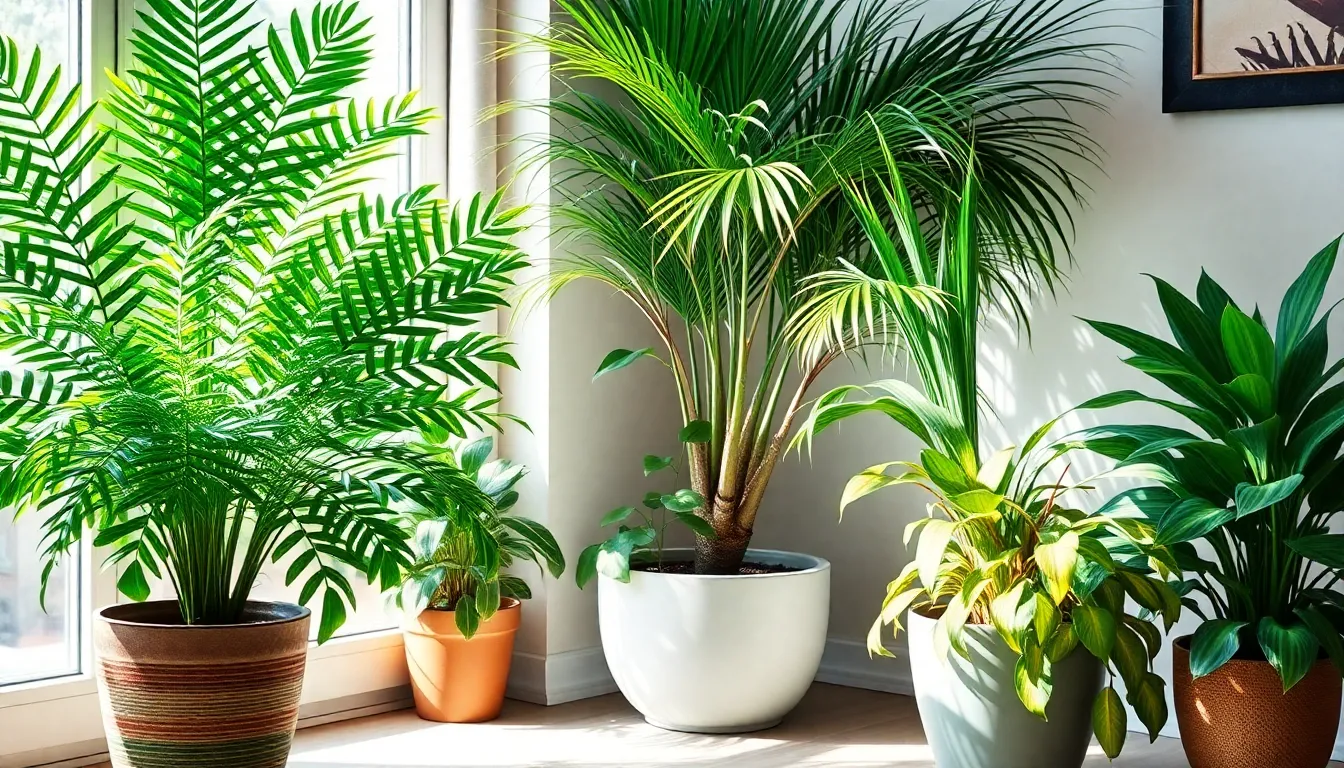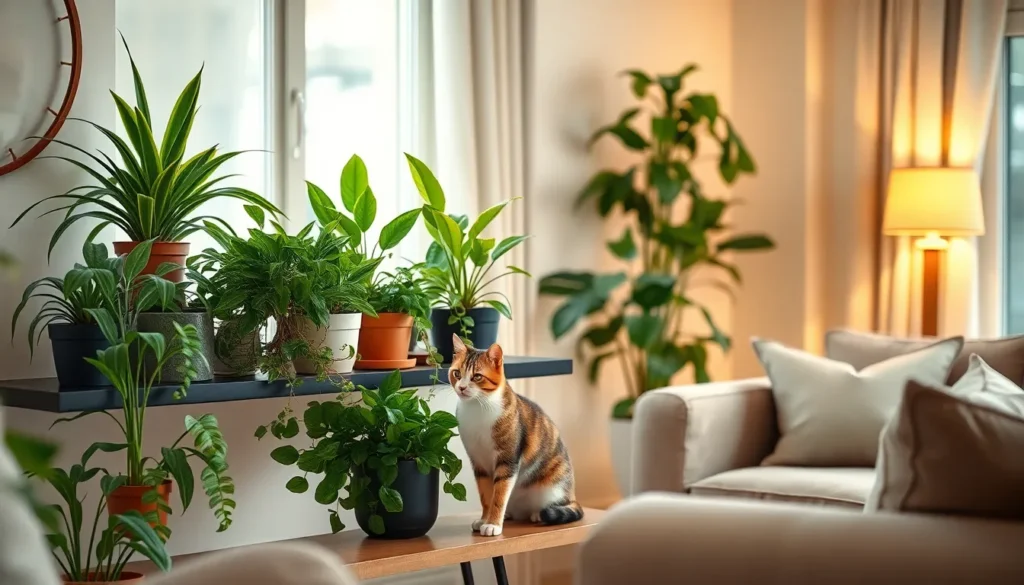Table of Contents
ToggleBringing greenery into a home can transform any space, but for cat lovers, it’s a delicate balancing act. While cats are curious creatures who love to explore, many popular houseplants can be toxic to them. So how do you keep your feline friend safe while still enjoying the beauty of indoor plants?
Enter the world of cat-friendly houseplants! These green companions not only brighten up a room but also keep those whiskered explorers safe from harm. Imagine a home filled with lush foliage that doesn’t have you playing plant detective every time your cat strolls by. From vibrant spider plants to resilient bamboo palms, there’s a perfect plant for every cat-loving household. Let’s dive into the delightful options that let you nurture your love for plants without compromising your furry friend’s well-being.
Importance Of Choosing Safe House Plants
Selecting safe house plants is essential for homes with cats. Many plants can pose severe health risks to felines, making the choice of greenery crucial.
Understanding Cat Safety
Understanding cat safety involves knowing which plants are toxic to pets. Several common houseplants, such as lilies and philodendrons, can cause adverse reactions in cats when ingested. Owners should research plant varieties before adding them to their homes. Non-toxic options, including spider plants and bamboo palms, provide aesthetic appeal while ensuring cats remain safe. Prioritizing plant safety helps create a harmonious living environment where both pets and plants thrive.
Common Risks To Cats
Common risks to cats often arise from ingesting harmful plants. Symptoms of poisoning can include vomiting, diarrhea, and lethargy. Specific plants pose greater threats; for instance, ingestion of azaleas can lead to severe discomfort. While some plants may seem harmless, their effects can endanger feline health. Recognizing signs of plant toxicity is crucial for prompt veterinary attention. Safe plant choices reduce these risks and contribute to a healthier home for cats.
Popular House Plants Safe For Cats

Choosing cat-friendly houseplants promotes a safer living space for both pets and plant lovers. Here are some popular options that won’t harm curious felines.
Spider Plant
Spider plants thrive in indirect light and are known for their air-purifying qualities. Their arching green leaves may attract cats, but they’re completely safe if chewed. Frequent watering isn’t necessary; allowing the soil to dry slightly between waterings keeps it healthy. Spider plants also produce “pups,” which can be propagated easily, offering more plants for your home.
Boston Fern
Boston ferns flourish in high humidity and low light settings, making them perfect for bathrooms or kitchens. These lush plants provide a vibrant green presence while remaining non-toxic to cats. Regular watering is essential to prevent drying out, making them ideal for a humid environment. Cats might enjoy the texture of the fronds, adding an interactive element to the plant.
Areca Palm
Areca palms bring a tropical feel indoors and can grow quite tall, adding height to room decor. This type of palm enjoys bright, indirect light and requires weekly watering to maintain its best appearance. Safe for cats, it poses no health risks if nibbled. Placing an Areca palm in a corner can create an inviting atmosphere, beneficial for both pets and their owners.
Benefits Of Having House Plants
House plants enhance indoor environments while ensuring safety for cats. They contribute to well-being, create inviting spaces, and offer numerous advantages.
Air Purification
Plants like spider plants and Boston ferns act as natural air purifiers. These species help reduce indoor air pollutants, absorbing toxins and releasing oxygen. By improving air quality, they enhance the comfort of living spaces, which benefits both humans and pets. Studies show that plants can effectively filter substances like formaldehyde and xylene, making homes healthier. Incorporating cat-friendly plants ensures that air purification occurs without endangering feline companions.
Aesthetic Appeal
House plants bring visual interest and color to interiors. They provide a touch of nature that livens up any setting, whether it’s a cozy living room or a bright kitchen. Unique shapes and textures create focal points, encouraging creativity in decor. Adding greenery improves mood and promotes relaxation, transforming spaces into serene environments. By choosing safe plants for cats, homeowners maintain visual harmony while ensuring pet safety.
Tips For Caring For House Plants With Cats
Caring for houseplants while accommodating cats presents unique challenges. Implementing thoughtful strategies ensures the safety of both plants and pets.
Placement Strategies
Positioning plants out of reach is vital. Elevated shelves or hanging planters create a cat-free zone for greenery. Placing plants in rooms where cats have limited access reduces the risk of curiosity. Additionally, utilizing plant stands can elevate houseplants, keeping them safe from playful paws. Choosing sturdy pots with wide bases also helps prevent tipping. Grouping plants in a designated area allows for easy monitoring of both plants and cats.
Cat Deterrent Techniques
Utilizing deterrents discourages cats from approaching plants. Spraying non-toxic deterrent solutions on leaves can create an unappealing experience for curious felines. Incorporating citrus peels around pots often works, as many cats dislike the scent. Offering alternative distractions, like cat grass or designated scratching posts, keeps cats engaged. Regularly trimming plant leaves discourages nibbling, and providing barriers like decorative rocks or mesh can protect vulnerable plants. Combining these techniques fosters a harmonious environment for both cats and plants.
Creating a safe and inviting home for both cats and houseplants is entirely achievable. By selecting non-toxic plants like spider plants and Boston ferns, cat owners can enjoy the beauty of greenery without compromising their pets’ health. The right choices not only enhance indoor aesthetics but also improve air quality and promote well-being.
Implementing practical care strategies ensures that both plants and pets coexist peacefully. With a little planning and awareness, it’s possible to cultivate a vibrant living space where cats can explore freely and plants can thrive. Embracing cat-friendly houseplants allows pet owners to enjoy the best of both worlds.







